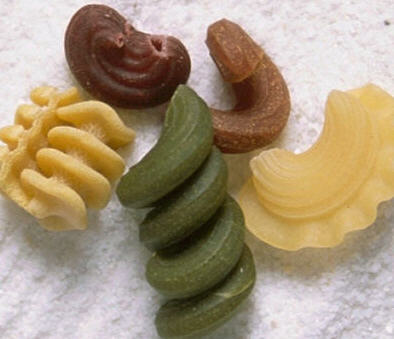Overview
After harvesting, grain is cleaned, tempered and coarsely milled. The milled wheat is combined with water, eggs, and any other ingredients, and blended in a large mixer. A twin shaft mixer is used to prevent the dough from forming balls. The dough is subjected to a vacuum to remove all air bubbles. The dough moves through an extruder, which forms the dough into a homogenous mass. The extruder is equipped with a cool water jacket to maintain a constant temperature of around 123º F (51º C). Temperatures higher than this will damage the dough. The pasta is extruded through Teflon to give it a smooth appearance and then it is dried to lower the moisture content.
Drying —
Drying is the most difficult and critical step to control in the pasta production process. The objective of drying is to lower the moisture content of the pasta from approximately 31 percent to 12 to 13 percent so that the finished product will be hard, retain its shape, and store without spoiling.
Most pasta drying operations use a preliminary drier immediately after extrusion to prevent the pasta from sticking together. Predrying hardens the outside surface of the pasta while keeping the inside soft and plastic. A final drier is then used to remove most of the moisture from the product. Drying temperature and relative humidity increments are important factors in drying. Since the outside surface of the pasta dries more rapidly than the inside, moisture gradients develop across the surface to the interior of the pasta. If dried too quickly, the pasta will crack, giving the product a poor appearance and very low mechanical strength. Cracking can occur during the drying process or as long as several weeks after the product has left the drier. If the pasta is dried too slowly, it tends to spoil or become moldy during the drying process. Therefore, it is essential that the drying cycle be tailored to meet the requirements of each type of product. If the drying cycle has been successful, the pasta will be firm but also flexible enough so that it can bend to a considerable degree before breaking.
Major Processes
Major Equipment
Natural Gas Technologies
More Information
www.sentech.org/CHP4foodprocessing/bakeries.htm
Source: Overview Text from http://www.sentech.org/CHP4foodprocessing/bakeries.htm#drypasta and http://www.epa.gov/ttn/chief/ap42/ch09/final/c9s09-5.pdf 4/2007; Overview pasta photo from http://www.pappardellesonline.com 6/2007;
